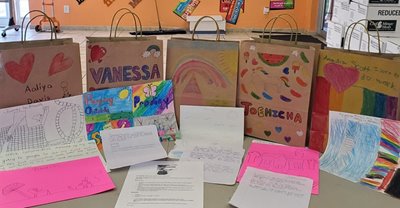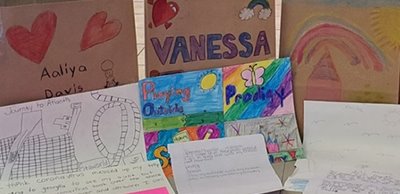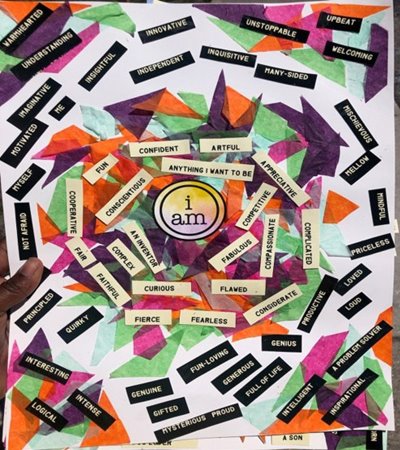During the COVID-19 outbreak, for many families served by the Orlando Neighborhood Improvement Corporation, days are spent hunkered at home. Activities stopped. Classes stopped or went virtual. Sometimes, it was hard to tell a Monday from a Saturday.
But the Florida NeighborWorks organization offered youth – and by extension, their families -- a way to stay creative while they were at home. The organization shifted programming and began offering art the same way many organizations have offered food during the pandemic: Grab and go.
 "We use art as a vehicle to teach life, coping, and leadership development skills," explains Alexis Collins, vice president for resident programs at the Orlando Neighborhood Improvement Corporation. "We utilize our youth program to promote problem solving and conflict resolution." At the root of ONIC's Prodigy Cultural Arts Program, she says, is expression, be it visual or performing arts. During COVID, they wanted the program to continue, even if they couldn't have everyone in one place. The projects are meant to engage kids ages 5 to 17, but whole families have participated.
"We use art as a vehicle to teach life, coping, and leadership development skills," explains Alexis Collins, vice president for resident programs at the Orlando Neighborhood Improvement Corporation. "We utilize our youth program to promote problem solving and conflict resolution." At the root of ONIC's Prodigy Cultural Arts Program, she says, is expression, be it visual or performing arts. During COVID, they wanted the program to continue, even if they couldn't have everyone in one place. The projects are meant to engage kids ages 5 to 17, but whole families have participated.
"We have leveraged the pandemic as an opportunity," Collins says. In the beginning, they weren't sure how successful they'd be, engaging families through a virtual platform. But because a good number of the youth in ONIC's multi-family communities accessed laptops or tablets for school, the technology became a portal to link the rest of the families to programming, too.
"Due to the pandemic, we have been able to engage youth 4 and under to participate in the program with their older siblings," says LaSonashia McFadden, resident services manager at the Orlando Neighborhood Improvement Corporation. "Parents, too. It's a creative outlet."
October is National Arts and Humanities Month, but at the ONIC, as in other NeighborWorks organizations, arts are a focus all year. A study conducted in 2017 showed that three fourths of NeighborWorks organizations strategically incorporated art into their work – and showed interest in doing more. 
"For a lot of our families, this is a difficult time," McFadden says. "This is a way for youth and families to connect and express themselves in ways that they haven't before, to find out that they're creative and more capable of expressing themselves through art. The pandemic has brought many hidden talents that our residents didn't realize they have."
Residents are encouraged to express their talents in a variety of forms. "Draw something. Write a song. Dance. There are so many avenues in art," McFadden says.
Collins says some of the students have been acting or dancing as they would in TikTok videos. "When they are fully participating in the performing arts, it's been remarkable." A NeighborWorks Community Leadership Institute project involved the facilitation and creation of a local cultural arts showcase, she adds.
McFadden says art helps with self-esteem building. One of the activities staff worked on with youth this year, for example, was an affirmation board, where the students had to write something positive about themselves. They kept the finished projects; they repeated the affirmations.
 After the death of George Floyd in May sent tremors across the United States, an art instructor with ONIC asked the kids to draw the things that were impacting them and share them virtually. The community is diverse, says Collins, who has been with the organization since 2000. Perspectives are different. And through art, they have a way to share those perspectives.
After the death of George Floyd in May sent tremors across the United States, an art instructor with ONIC asked the kids to draw the things that were impacting them and share them virtually. The community is diverse, says Collins, who has been with the organization since 2000. Perspectives are different. And through art, they have a way to share those perspectives.
Art helps with social isolation, adds McFadden. And the grab-and-go projects provide a way for staff to check on youth and their families to make sure they're okay. "We already do wellness phone calls, but that's over the phone. This is another way to check on kids and give them something else besides their schoolwork and being bored at home."
ONIC has 11 communities and has implemented a formal cultural arts program at five of them. But the organization offers art projects to all its community during the year. They served 150 students in classes last year, but outside of classes, the number was more like 300, Collins says.
Before COVID hit, art classes were place-based, held for 90 minutes two days a week. Now, the classes are online and shorter, because students are already maxed out with virtual learning, McFadden says. Residents are asked to pick up bags of art supplies, but if they're unable to do so, staff will deliver materials to a child's home or a parent's job.
"I think we have always known the importance of art," Collins says. "But art is crucial now for everyone. It's that outlet. It's the break in the day." And it's one way to help people trying to cope with the pandemic, she adds.
10/27/2020

